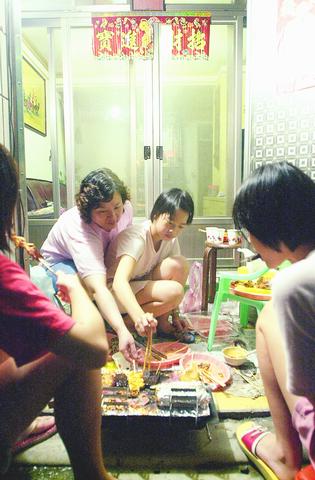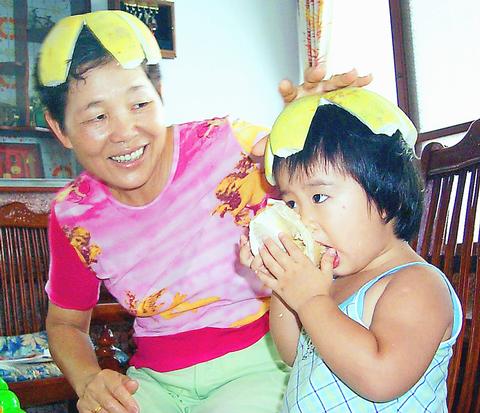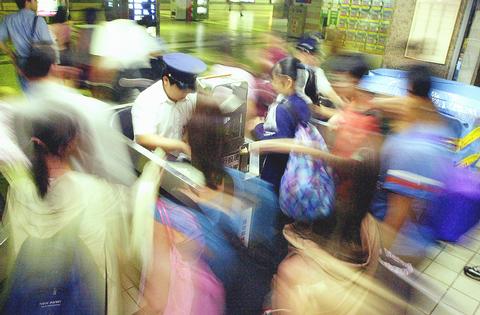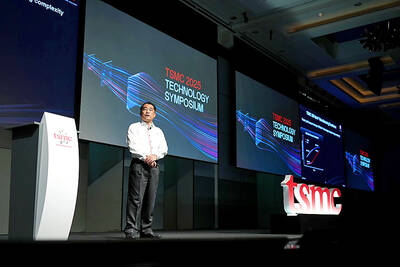Yeh Chu-lan (葉菊蘭), minister of transportation and communications, yesterday asked for travelers' tolerance and understanding in the face of transportation chaos during the Mid-Autumn Festival, blaming recent typhoons for the mayhem.
Yeh inspected transport conditions in the country early yesterday, the last day of the holiday, using computer monitoring systems at Taipei Railway Station, Sungshan Airport and the highway bureau in Taipei County.

PHOTO: GEORGE TSORNG, TAIPEI TIMES
It was expected that northbound traffic would face severe congestion yesterday, as people returned home in readiness for work and school today.

PHOTO: SU CHUN-HSIEN, TAIPEI TIMES
"Travelers on the highways, railways and airways suffered significant inconvenience. But I believe that they all understand that typhoons Toraji, Nari and Lekima are responsible," Yeh said.
Road and rail networks took a battering from each of the three typhoons, which brought torrential rains, the first in late July, the other two late last month.

PHOTO: GEORGE TSORNG, TAIPEI TIMES
Saying that the agencies concerned would examine their past performance during holidays in order to make future improvements, Yeh emphasized that the ministry had planned ahead to divert traffic during the holidays.

PHOTO: GEORGE TSORNG, TAIPEI TIMES
At the beginning of the holiday on Saturday, several domestic airports experienced temporary closures because of the downpours brought by Typhoon Lekima. Damage to railways at many locations had not been fully repaired by Friday, despite a promise from the Taiwan Railway Administration (TRA,
Yeh said yesterday that all staff of the transportation agencies had done their best, some even sacrificing sleep to help fix problems.
Huang Te-chi (
But some TRA staff felt that pressure from the ministry had caused the TRA's management to underestimate the time required to repair the damage. On Friday and Saturday, most trains suffered delays, some up to five hours, because of repair work.
"The ministry and the railway's top administration set a deadline for the repairs and announced it to the public. But our engineers knew that the goal was impossible to achieve," said Cheng Yu-sheng (
"Forcing all the trains to operate while conditions on the roads were still poor after initial repairs was responsible for the rail congestion," he added.
Rail services were less impaired yesterday than on Saturday. But trains were still arriving 20 minutes late on average.
Northbound freeways were packed after 3:00pm yesterday. On some sections, cars could not exceed 30kph.

DEMOGRAPHICS: Robotics is the most promising answer to looming labor woes, the long-term care system and national contingency response, an official said Taiwan is to launch a five-year plan to boost the robotics industry in a bid to address labor shortages stemming from a declining and aging population, the Executive Yuan said yesterday. The government approved the initiative, dubbed the Smart Robotics Industry Promotion Plan, via executive order, senior officials told a post-Cabinet meeting news conference in Taipei. Taiwan’s population decline would strain the economy and the nation’s ability to care for vulnerable and elderly people, said Peter Hong (洪樂文), who heads the National Science and Technology Council’s (NSTC) Department of Engineering and Technologies. Projections show that the proportion of Taiwanese 65 or older would

Nvidia Corp yesterday unveiled its new high-speed interconnect technology, NVLink Fusion, with Taiwanese application-specific IC (ASIC) designers Alchip Technologies Ltd (世芯) and MediaTek Inc (聯發科) among the first to adopt the technology to help build semi-custom artificial intelligence (AI) infrastructure for hyperscalers. Nvidia has opened its technology to outside users, as hyperscalers and cloud service providers are building their own cost-effective AI chips, or accelerators, used in AI servers by leveraging ASIC firms’ designing capabilities to reduce their dependence on Nvidia. Previously, NVLink technology was only available for Nvidia’s own AI platform. “NVLink Fusion opens Nvidia’s AI platform and rich ecosystem for

Taiwan Semiconductor Manufacturing Co (TSMC, 台積電) yesterday said it is building nine new advanced wafer manufacturing and packaging factories this year, accelerating its expansion amid strong demand for high-performance computing (HPC) and artificial intelligence (AI) applications. The chipmaker built on average five factories per year from 2021 to last year and three from 2017 to 2020, TSMC vice president of advanced technology and mask engineering T.S. Chang (張宗生) said at the company’s annual technology symposium in Hsinchu City. “We are quickening our pace even faster in 2025. We plan to build nine new factories, including eight wafer fabrication plants and one advanced

‘WORLD’S LOSS’: Taiwan’s exclusion robs the world of the benefits it could get from one of the foremost practitioners of disease prevention and public health, Minister Chiu said Taiwan should be allowed to join the World Health Assembly (WHA) as an irreplaceable contributor to global health and disease prevention efforts, Minister of Foreign Affairs Lin Chia-lung (林佳龍) said yesterday. He made the comment at a news conference in Taipei, hours before a Taiwanese delegation was to depart for Geneva, Switzerland, seeking to meet with foreign representatives for a bilateral meeting on the sidelines of the WHA, the WHO’s annual decisionmaking meeting, which would be held from Monday next week to May 27. As of yesterday, Taiwan had yet to receive an invitation. Taiwan has much to offer to the international community’s